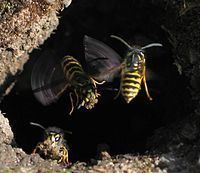Scientific name Aculeata Rank Infraorder | ||
 | ||
Length Early bumblebee: 1 – 1.4 cm Lifespan Western honey bee: 122 – 152 days, Early bumblebee: 28 days Lower classifications Bee, Apoidea, Bethylidae, Dryinidae, Chrysidini | ||
Stichotria aculeata the ovni
Aculeata is a subclade of Hymenoptera. The name is a reference to the defining feature of the group, which is the modification of the ovipositor into a stinger (thus, the group could be called "stinging wasps", though the group also contains the ants and the bees). In other words, the structure that was originally used to lay eggs is modified instead to deliver venom. Not all members of the group can sting; a great many cannot, either because the ovipositor is modified in a different manner (such as for laying eggs in crevices), or because it is lost altogether.
Contents
- Stichotria aculeata the ovni
- Iain peterson a new biological control for pereskia aculeata may 2013
- Classification
- References
This group includes the bees and ants and all of the eusocial Hymenopterans. It is commonly believed that the possession of a venomous sting was one of the important features promoting the evolution of social behavior, as it confers a level of anti-predator defense rarely approached by other invertebrates.
Iain peterson a new biological control for pereskia aculeata may 2013
Classification
The use of the name Aculeata has a long history at the rank of infraorder or division. The Aculeata is a good natural group, containing all the descendants of a single common ancestor.
The Aculeata are therefore maintained as a taxon, either at infraorder or division rank or as an unranked clade.
Among the parasitic wasps the Ichneumonoidea seem particularly closely related to the Aculeata. If taxonomic ranks are used, it may therefore be best to treat the latter as a division and divide the Apocrita into some 6 infraorders representing lineages of about equal standing, one of which would unite the Aculeata and the Ichneumonoidea.
Note that having the same taxonomic rank does not imply equal evolutionary standing, whereas placement in the same higher-ranked taxon ideally does, or at least implies that regardless of what specific rank they have, the lower-ranked taxa are all part of the same evolutionary radiation. Therefore, would the Aculeata and the Ichneumonoidea be placed in an infraorder, the former would still be considered a division and the latter a superfamily. Despite having different ranks, they would be members of the same taxon and sister lineages.
